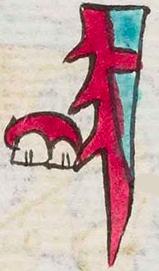Huitztlan (Mdz13v)
This compound glyph for the place name Huitztlan features a bloody maguey spike, spine, or thorn (huitztli) and two front teeth (tlantli), intended as the phonetic value for the locative suffix, -tlan. The spike or spine has smaller thorns going down the left side. The two teeth are to the left of the spine, touching one of the smaller thorns. The teeth are two, upper, front teeth, white with red gums.
Stephanie Wood
Thorns had ritual uses related to sacrificial bloodletting. Blood-stained thorns are mentioned in various attestations in our online Nahuatl Dictionary for the word huitztli, and this may explain the choice of red coloring on the point and edges of the thorn or spike shown in this glyph. The other color, turquoise, may convey the thorn's plant origin, given that the word for turquoise (xihuitl) is a synonym for plant greenery. Some maguey plants have a bluish color, and turquoise was also a color signifying preciosity. A thorn used for self-sacrifice and religious offerings would be precious.
Stephanie Wood
huiztlan. puo
Huitzlan, pueblo
Stephanie Wood
c. 1541, or by 1553 at the latest
Stephanie Wood
thorns, spines, teeth, dientes, espinas, magueyes, nombres de lugares

huitz(tli), spike, spine, or thorn, https://nahuatl.wired-humanities.org/content/huitztli
tlan(tli), tooth/teeth, https://nahuatl.wired-humanities.org/content/tlantli
-tlan (locative suffix), by, near, among, https://nahuatl.wired-humanities.org/content/tlan
"Spine/Thorn Place" [Frances Karttunen, unpublished manuscript, used here with her permission.]
"By the Thorns" (Whittaker, 2021, 67); "Place of Many Thorns" or "South" (Berdan and Anawalt, 1992, vol. 1, p. 190)
Codex Mendoza, folio 13 verso, https://digital.bodleian.ox.ac.uk/objects/2fea788e-2aa2-4f08-b6d9-648c00..., image 37 of 188.
The Bodleian Libraries, University of Oxford, hold the original manuscript, the MS. Arch. Selden. A. 1. This image is published here under the UK Creative Commons, “Attribution-NonCommercial-ShareAlike 3.0 License” (CC-BY-NC-SA 3.0).





